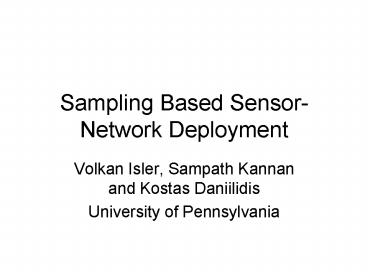Sampling Based Sensor-Network Deployment - PowerPoint PPT Presentation
1 / 28
Title:
Sampling Based Sensor-Network Deployment
Description:
3 points shattered by 8 disks: for any subset of these 3 points, ... 4 points can not be shattered: There are no disks that contain only the black points. ... – PowerPoint PPT presentation
Number of Views:18
Avg rating:3.0/5.0
Title: Sampling Based Sensor-Network Deployment
1
Sampling Based Sensor-Network Deployment
- Volkan Isler, Sampath Kannan and Kostas
Daniilidis - University of Pennsylvania
2
Outline
- Background knowledge
- Deployment Methods
- Conclusion
- Discussion
3
Outline
- Background knowledge
- Deployment Methods
- Conclusion
- Discussion
4
Deployment
- How to place sensor nodes in the target area
- In this paper, authors assumed it is impossible
or very difficult to place sensors precisely (ex.
Dissemination from airplane on foreign territory) - Result in random geometric networks
5
Deployment
- Two important requirements Coverage and
Connectivity - Coverage Every point in the environment is
within the range of at least one sensor - Connectivity Every sensor can communicate with
every other sensor
6
Deployment
- Problem What is the minimum number of sensors
needed for guaranteed coverage and connectivity? - Reasons why need minimum
- Too much cause interference, and easily detected
by adversaries - Decrease invasiveness in natural environment
7
Two ways for deployment
- Deployment be accomplished in one step
- If deployment can implemented in multiple steps
? incremental deployment
8
Sampling Based?
- The sample here is a term in machine learning
- Find most representative samples
- Sample Sensor units
9
Critical Concepts
- Set-Systems
- Vapnik-Chervonenkis (VC) dimension
10
Set System
EX X 1,2,3 R , 1, 2,
3, 1,2, 1,3, 2,3, 1,2,3
11
VC-dimension
- a measure of the capacity of a statistical
classification algorithm
VC-dimension
12
VC-dimension
Find VC-dimension for disk set system
X all the points on the plane A the 3 black
points, is a subset of X
13
VC-dimension
VC-dimension
Y is a subset of A (the 3 black points) R is the
certain subset of X such that R intersect A
become to Y (R is a certain collection of points
on the plane)
14
VC-dimension
R
Find VC-dimension for disk set system
Y
Y is a subset of A (the 3 black points) R is the
certain subset of X such that R intersect A
become to Y (R is a certain collection of points
on the plane)
15
VC-dimension
Find VC-dimension for disk set system
3 points shattered by 8 disks for any subset of
these 3 points, there exists a disk that contains
only those points and none other.
16
VC-dimension
4 points can not be shattered There are no disks
that contain only the black points. So 3 is
VC-dimension of the disk set system
17
Definition
Let sampling points form an . If
the size of event (R) is larger than specific
range (epsilon), the event will be intersected by
one of the sampling point.
If the sensors form an ,
this means any activity within a specified range
(determined by epsilon) will be intersected
(detected) by one of the sensors
18
Outline
- Background knowledge
- Deployment Methods
- Conclusion
- Discussion
19
One Step Deployment
- Find the necessary number of sensors to form
- By calculate
- - with this much points drawn at random from R
is an epsilon-net with probability at least - Place at location chosen uniformly
20
(No Transcript)
21
One Step Deployment
- Make sure the connectivity
- Derive the lower bound communication range by
(random graph connectivity)
communication range
n n points sampled uniformly p graph is
connected with probability p
22
Multiple Steps Deployment
Trivial but not ensure the connectivity
23
SampleWithoutReplacement
24
Multiple Steps Deployment
25
SampleWithoutReplacdementwithComm
26
Conclusion
- Guarantee coverage and connectivity using a few
sensors as possible - Model is general and simple, but can present
bounds on the number of sensor required - Two scenarios have been address concurrent and
incremental deployment
27
Discussion
- The target application for this paper is outdoor
deployment, can we use these methods in indoor
deployment?
28
- Thank you!































